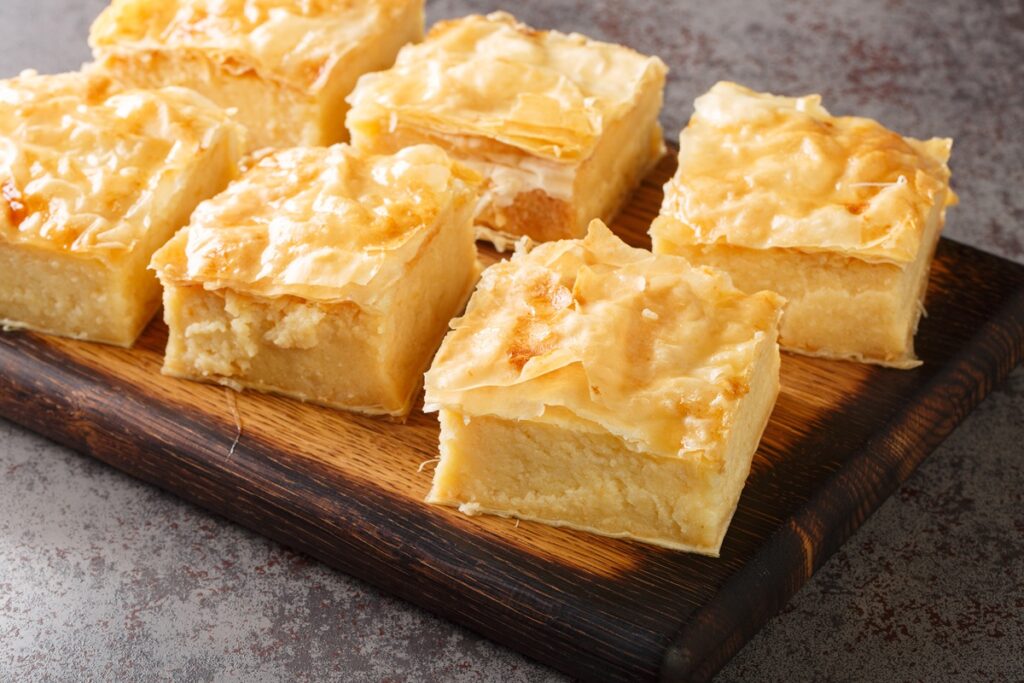No culinary journey through Greece is complete without indulging in its irresistible, delicious Greek desserts — a symphony of honey, nuts, spices, and golden filo pastry that tells the story of a nation shaped by both land and history. Greek sweets are not merely after-meal indulgences; they are a celebration of hospitality (filoxenia), family gatherings, and centuries of culinary exchange between East and West.
Across the Greek islands and mainland, desserts reflect a mosaic of influences — from the honey-drenched pastries of the Byzantine era and the aromatic syrups of Ottoman kitchens to the sun-kissed fruits of the Mediterranean coast. Many delicious Greek desserts are made with simple ingredients, making them accessible and easy to prepare at home. Each region adds its own twist: Cretan patisseries use local thyme honey and almonds, northern Greece favours semolina and custard desserts, and the Aegean islands specialise in almond-based confections scented with rosewater.
You’ll find these sweets everywhere — served after long seaside lunches, at cosy mountain cafés, during festive panigyria (village fairs), or as gifts from a host to a guest. To taste them is to experience Greek culture itself: generous, layered, and timeless.
So, loosen your belt and follow your sweet tooth through this journey of Greece’s most beloved confections — from ancient honey cakes to modern patisserie masterpieces.
Introduction to Greek Food and Sweets
Greek cuisine is a celebration of life’s simple pleasures, and nowhere is this more evident than in its array of irresistible desserts. Greek desserts are a delicious testament to the country’s rich culinary heritage, blending key ingredients like golden honey, crunchy walnuts, and delicate phyllo dough into sweet masterpieces. Whether it’s the iconic baklava with its layers of crisp phyllo and sweet syrup, or a bowl of creamy yoghurt drizzled with honey, each dessert tells a story of tradition and togetherness. These sweet treats are more than just an end to a meal—they’re a cherished part of Greek culture, often served at festive gatherings, family celebrations, and moments of hospitality. For anyone with a sweet tooth, exploring Greek desserts is a journey through the heart of Greek cuisine, where every bite is infused with history, flavour, and the warmth of Greek hospitality.
1. Baklava – The Queen of Greek Sweets
No Greek dessert list is complete without baklava, the crown jewel of Greek patisserie.
Crisp layers of golden filo pastry are filled with chopped nuts like crushed walnuts or pistachios, soaked in just the right amount of honey or spiced syrup, and scented with cinnamon and clove. The baking process is essential—baklava is baked until the phyllo turns golden brown, ensuring a perfect texture and beautiful presentation. Each bite is an ideal balance of crunch, sweetness, and spice, making baklava a fantastic dessert.
➡️ Best enjoyed during food tours or at traditional patisseries in Athens and Thessaloniki.
2. Galaktoboureko – Custard Wrapped in Filo
This creamy semolina custard pie is assembled in a baking pan using layers of phyllo sheets brushed with melted butter. Each phyllo sheet is carefully buttered to create a crispy texture. The custard is poured over the layered phyllo, then more phyllo sheets are added on top, with buttering between each layer. After baking until golden, the cooled syrup is poured over the hot pastry, allowing it to soak in without making the dessert soggy.
Its name comes from “galacto” (milk) and “boureko” (filled pastry). Served warm, it’s rich yet comforting — a favourite in both bakeries and home kitchens throughout Greece.
3. Kataifi – Golden Threads of Sweetness
Looking like spun gold, kataifi is made from finely shredded filo dough, rolled around a filling of nuts and spices, then baked until golden brown and soaked in honey syrup.
Its crisp, delicate texture and nutty filling make it a festive favourite, often decorated with chopped pistachios or almonds.
4. Kourabiedes – Greek Almond Shortbread Cookies
These melt-in-your-mouth butter cookies, dusted with a generous snowfall of icing sugar, are a Christmas favourite across Greece.
Made with toasted almonds, pure butter, and a hint of vanilla powder for enhanced aroma and taste, kourabiedes symbolise celebration and are traditionally served at weddings, baptisms, and holidays. Before baking, the cookies are arranged on a baking sheet to ensure even cooking and prevent sticking.
5. Loukoumades – Greek Honey Doughnuts
Crispy on the outside, fluffy inside, loukoumades are a sweet treat—small fried dough balls soaked in honey syrup and sprinkled with cinnamon and crushed walnuts. Making or eating loukoumades is so much fun, and people of all ages enjoy them.
They trace their origins back to ancient Greece, where similar treats were offered to Olympic champions as “honey tokens of victory.”
➡️ Find them fresh at street markets or food walking tours in the Peloponnese — sometimes topped with chocolate or sesame.
6. Ravani (or Revani) – Syrup-Soaked Semolina Cake
A moist, grainy semolina cake infused with orange or lemon zest, ravani is an excellent recipe for those seeking a simple yet flavorful dessert found in every Greek household.
Lightly spiced and soaked in citrusy syrup, it’s both refreshing and satisfying — the perfect finale to a rich Mediterranean meal. Ravani is sometimes flavoured like a Greek orange cake, sharing the same syrup-soaked, moist texture and citrus notes that make both desserts popular among traditional Greek sweets.
7. Diples – The Sweet Folds of the Peloponnese
A Peloponnesian speciality, diples are thin sheets of dough fried until crisp, folded into ribbons or spirals, and drenched in honey syrup with walnuts and cinnamon.
Traditionally prepared at weddings and celebrations, they symbolise prosperity and happiness.
➡️ Don’t miss them in Kalamata or Mani — handmade, fragrant, and best eaten warm.
8. Glyka tou Koutaliou – Spoon Sweets
These “spoon sweets” are the purest expression of Greek hospitality.
Fruits, nuts, and even vegetables (such as figs, cherries, or bitter oranges) are slowly simmered in sugar syrup and served to guests on a spoon with a glass of cold water.
Every region has its speciality — in the Peloponnese, rose petal and quince reign supreme; in Crete, try citrus peel or carob.
9. Bougatsa – Breakfast or Dessert Bliss
A flaky filo pastry filled with creamy custard, dusted with cinnamon and powdered sugar, bougatsa is a beloved breakfast treat that doubles as dessert. A traditional bougatsa recipe involves preparing a rich custard filling, layering it between sheets of phyllo dough in a baking pan, and carefully baking until golden and crisp. Originating in northern Greece, it’s now found in bakeries nationwide. Bougatsa is best served hot, straight from the oven, making it perfect for breakfast or as a sweet treat with a cup of Greek coffee or an iced frappé.
10. Moustalevria – Grape Must Pudding
Made from fresh grape must (moustos), semolina, and nuts, this ancient dessert dates back to classical times.
Thickened into a silky pudding, it’s often made during the grape harvest in September — proof that Greek sweets follow the seasons as faithfully as they follow tradition.
11. Melomakarona – Honey-Soaked Christmas Cookies
Soft, spiced cookies flavoured with orange, cinnamon, and cloves, and studded with orange zest, melomakarona are soaked in honey syrup and topped with chopped walnuts.
Made with olive oil instead of butter, they’re tender, fragrant, and quintessentially festive.
➡️ Best enjoyed fresh from local bakeries during Christmas — they often sit beside trays of snowy kourabiedes. Serve melomakarona to guests for a delicious and impressive holiday treat.
12. Karidopita – Walnut Cake with Cinnamon and Syrup
Dense, aromatic, and soaked in sweet syrup, karidopita (from karidi, walnut) is a classic Greek dessert with deep roots in Greek culinary tradition. Flavoured with cinnamon and clove, it’s often served warm with a scoop of vanilla ice cream or a drizzle of melted chocolate.
➡️ You’ll find it in traditional tavernas, especially in the mountainous regions of Epirus and Thessaly.
13. Pasteli – The Ancient Energy Bar
Honey and sesame — that’s all you need for pasteli, Greece’s original energy bar.
Dating back to ancient times, this chewy, nutty sweet has fueled travellers and athletes for centuries. Some versions add almonds or pistachios for extra crunch.
➡️ Look for handmade pasteli in Mani and Crete, where local thyme honey gives each bar its unique aroma.
14. Amygdalota – Greek Almond Cookies
Soft, chewy almond cookies with the delicate fragrance of rosewater or orange blossom.
Traditionally served at weddings and festivals, amygdalota vary by region: on Hydra and Spetses, they’re shaped like hearts or teardrops, while on Andros, they’re diamond-shaped and lightly crisped.
Naturally gluten-free and lightly sweet, they’re perfect with a cup of Greek coffee or a small glass of dessert wine.
15. Rizogalo – Greek Rice Pudding
Simple but irresistible, rizogalo (rice milk) is Greece’s answer to comfort food. Made with creamy milk, short—grain rice (for extra creaminess), sugar, and cinnamon, it’s served chilled in small bowls and topped with a dusting of cinnamon. Every Greek family has its own version — some thick and custardy, others silky and light — but all feel like a grandmother’s hug in dessert form.
16. Samali – Syrup-Soaked Semolina and Yoghurt Cake
A dense, aromatic cake made with coarse semolina, yoghurt, and a touch of mastiha — a resin from the island of Chios that lends a subtle pine-vanilla aroma. Once baked, samali is soaked in syrup and cut into diamond shapes, often decorated with an almond on top. Samali is a traditional Greek dessert enjoyed at festivals and family gatherings.
➡️ You’ll find it in northern Greece and the islands, particularly during summer festivals and religious feasts.
Chocolate in Greek Desserts – A Modern Twist
While honey and nuts have long been the stars of traditional Greek desserts, chocolate has recently taken its place alongside these classic ingredients, adding a new layer of indulgence to the Greek dessert table. Today, chocolate lovers can find their favourite treat woven into both time-honoured and contemporary recipes. Imagine biting into a piece of baklava drizzled with rich chocolate, or savouring a slice of galaktoboureko with a decadent chocolate twist. Greek patisseries now offer everything from chocolate mousse cakes to chocolate-dipped pastries, blending the best of traditional Greek desserts with the irresistible allure of chocolate. This modern approach not only honours the roots of Greek dessert-making but also invites a new generation to fall in love with these sweet creations. For those seeking a delicious dessert that bridges the gap between old and new, the chocolate-infused Greek sweets scene is a must-try.
Modern Greek Desserts – Sweet Innovation
The world of Greek desserts is experiencing a renaissance, as chefs and home bakers alike experiment with new ingredients and creative techniques. Modern Greek desserts are all about innovation—think rice pudding made with lactose-free milk for a lighter, dairy-friendly treat, or creamy custard infused with orange blossom water for a fragrant twist on a classic. These inventive recipes often feature fresh fruits, aromatic spices, and a variety of nuts, resulting in desserts that are as visually stunning as they are delicious. Whether it’s a pistachio-studded pastry or a reimagined baklava, today’s Greek dessert scene caters to every sweet tooth and dietary preference. This blend of tradition and creativity showcases the versatility of Greek cuisine, proving that classic flavours can be reinvented to create amazing desserts for every palate. If you’re eager to explore beyond the classics, modern Greek desserts offer a perfect combination of heritage and innovation—each bite a delightful surprise.
A Sweet Farewell
From the syrupy layers of baklava to the crisp folds of diples and the nutty comfort of karidopita, classic Greek desserts are more than confections — they’re edible stories passed down through generations.
Each bite captures a piece of Greek culture: the honey of the mountains, the citrus of island orchards, the spices of trade routes, and the warmth of a family kitchen. The variety of delicious Greek desserts highlights the rich culinary heritage and irresistible appeal of these treats. To share dessert in Greece is to share tradition, laughter, and love.
Tips for Dessert Lovers in Greece
- Visit a local Zacharoplasteio — pastry shops are treasure troves of regional sweets, and you might even find the Greek version of your favourite dessert.
- Join a dessert-making workshop in Athens, Crete, or the Peloponnese to learn the secrets of filo, syrup, and honey glazing. Many Greek dessert recipes are super easy to make at home, perfect for beginners.
- Pair wisely: syrupy sweets go best with strong Greek coffee or chilled water to balance the sweetness. For an extra touch, try topping your sweet treat with chocolate sprinkles.
- Travel with the seasons: in winter, try baklava, melomakarona, and kourabiedes; in summer, opt for spoon sweets, rizogalo, and amygdalota. When making these at home, vanilla extract or vanilla essence is a common flavouring in many Greek dessert recipes.
- Eat fresh: most syrupy desserts are best enjoyed the same day — their texture softens over time.
Tip: Greeks have a long tradition of dessert-making, and trying a traditional Greek dessert recipe at home is a delicious way to experience their culture.
Greek desserts are a bridge between ancient customs and modern indulgence — proof that sweetness has always been part of life here. Whether you taste them at a seaside taverna, a mountain café, or a grandmother’s kitchen, one thing is sure: you’ll leave Greece with honey on your lips and a smile in your heart.




